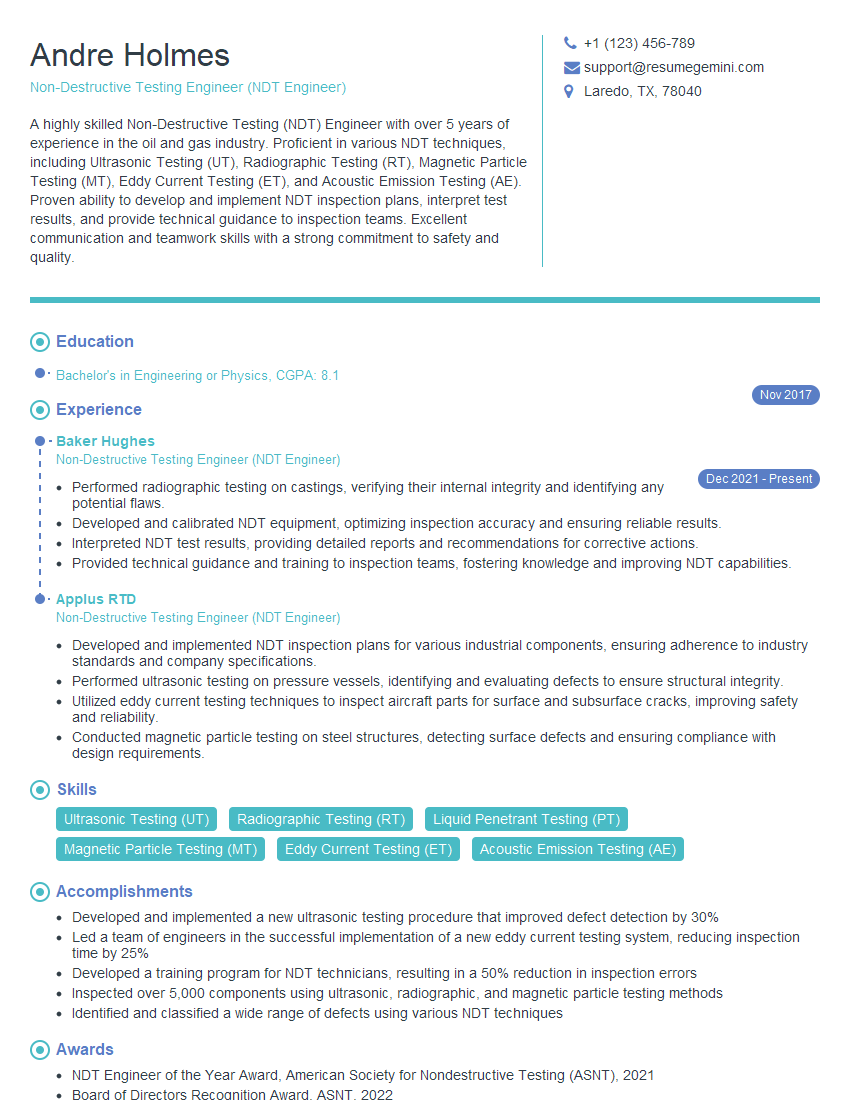Are you a seasoned Non-Destructive Testing Engineer (NDT Engineer) seeking a new career path? Discover our professionally built Non-Destructive Testing Engineer (NDT Engineer) Resume Template. This time-saving tool provides a solid foundation for your job search. Simply click “Edit Resume” to customize it with your unique experiences and achievements. Customize fonts and colors to match your personal style and increase your chances of landing your dream job. Explore more Resume Templates for additional options.

Andre Holmes
Non-Destructive Testing Engineer (NDT Engineer)
Summary
A highly skilled Non-Destructive Testing (NDT) Engineer with over 5 years of experience in the oil and gas industry. Proficient in various NDT techniques, including Ultrasonic Testing (UT), Radiographic Testing (RT), Magnetic Particle Testing (MT), Eddy Current Testing (ET), and Acoustic Emission Testing (AE). Proven ability to develop and implement NDT inspection plans, interpret test results, and provide technical guidance to inspection teams. Excellent communication and teamwork skills with a strong commitment to safety and quality.
Education
Bachelor’s in Engineering or Physics
November 2017
Skills
- Ultrasonic Testing (UT)
- Radiographic Testing (RT)
- Liquid Penetrant Testing (PT)
- Magnetic Particle Testing (MT)
- Eddy Current Testing (ET)
- Acoustic Emission Testing (AE)
Work Experience
Non-Destructive Testing Engineer (NDT Engineer)
- Performed radiographic testing on castings, verifying their internal integrity and identifying any potential flaws.
- Developed and calibrated NDT equipment, optimizing inspection accuracy and ensuring reliable results.
- Interpreted NDT test results, providing detailed reports and recommendations for corrective actions.
- Provided technical guidance and training to inspection teams, fostering knowledge and improving NDT capabilities.
Non-Destructive Testing Engineer (NDT Engineer)
- Developed and implemented NDT inspection plans for various industrial components, ensuring adherence to industry standards and company specifications.
- Performed ultrasonic testing on pressure vessels, identifying and evaluating defects to ensure structural integrity.
- Utilized eddy current testing techniques to inspect aircraft parts for surface and subsurface cracks, improving safety and reliability.
- Conducted magnetic particle testing on steel structures, detecting surface defects and ensuring compliance with design requirements.
Accomplishments
- Developed and implemented a new ultrasonic testing procedure that improved defect detection by 30%
- Led a team of engineers in the successful implementation of a new eddy current testing system, reducing inspection time by 25%
- Developed a training program for NDT technicians, resulting in a 50% reduction in inspection errors
- Inspected over 5,000 components using ultrasonic, radiographic, and magnetic particle testing methods
- Identified and classified a wide range of defects using various NDT techniques
Awards
- NDT Engineer of the Year Award, American Society for Nondestructive Testing (ASNT), 2021
- Board of Directors Recognition Award, ASNT, 2022
- Excellence in Nondestructive Testing Award, ASNT, 2023
Certificates
- ASNT Level III Certification in UT, RT, PT, MT, and ET
- API 510 Pressure Vessel Inspector Certification
- AWS Certified Welding Inspector (CWI)
- NDT Level II Certification in UT, RT, PT, MT, and ET
Career Expert Tips:
- Select the ideal resume template to showcase your professional experience effectively.
- Master the art of resume writing to highlight your unique qualifications and achievements.
- Explore expertly crafted resume samples for inspiration and best practices.
- Build your best resume for free this new year with ResumeGemini. Enjoy exclusive discounts on ATS optimized resume templates.
How To Write Resume For Non-Destructive Testing Engineer (NDT Engineer)
Highlight your skills and experience:
Quantify your accomplishments and use specific examples to demonstrate your expertise in NDT techniques.Tailor your resume to the job description:
Review the job description carefully and tailor your resume to match the specific requirements of the position.Use keywords:
Include relevant keywords throughout your resume to increase its visibility to recruiters.Proofread carefully:
Before submitting your resume, proofread it carefully for any errors in grammar, spelling, or formatting.
Essential Experience Highlights for a Strong Non-Destructive Testing Engineer (NDT Engineer) Resume
- Developed and implemented NDT inspection plans for various industrial components, ensuring adherence to industry standards and company specifications.
- Performed ultrasonic testing on pressure vessels, identifying and evaluating defects to ensure structural integrity.
- Utilized eddy current testing techniques to inspect aircraft parts for surface and subsurface cracks, improving safety and reliability.
- Conducted magnetic particle testing on steel structures, detecting surface defects and ensuring compliance with design requirements.
- Performed radiographic testing on castings, verifying their internal integrity and identifying any potential flaws.
- Interpreted NDT test results, providing detailed reports and recommendations for corrective actions.
- Provided technical guidance and training to inspection teams, fostering knowledge and improving NDT capabilities.
Frequently Asked Questions (FAQ’s) For Non-Destructive Testing Engineer (NDT Engineer)
What is the role of a Non-Destructive Testing Engineer?
A Non-Destructive Testing (NDT) Engineer is responsible for performing and evaluating NDT inspections to ensure the integrity and safety of industrial components and structures.
What are the different types of NDT techniques?
Common NDT techniques include Ultrasonic Testing (UT), Radiographic Testing (RT), Magnetic Particle Testing (MT), Eddy Current Testing (ET), and Acoustic Emission Testing (AE).
What industries use NDT?
NDT is used in various industries, including oil and gas, aerospace, automotive, manufacturing, and construction.
What are the qualifications to become an NDT Engineer?
Typically, a Bachelor’s in Engineering or Physics is required, along with relevant experience and certifications in NDT techniques.
What are the career opportunities for NDT Engineers?
NDT Engineers can work in various roles, including inspection engineer, quality control engineer, and technical consultant.
What is the salary range for NDT Engineers?
The salary range for NDT Engineers varies depending on experience, location, and industry, but it typically falls within the range of $60,000 to $120,000 per year.